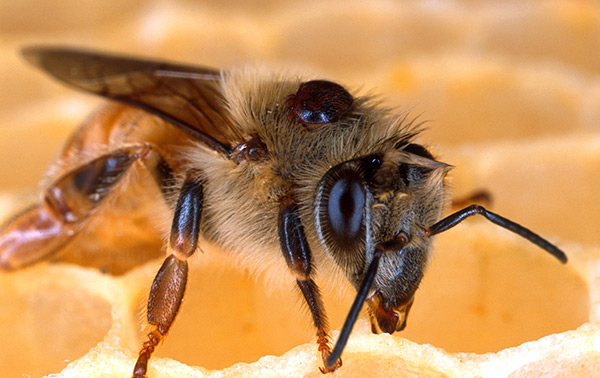Tool to Assess Bee Health Goes Viral
 |
|
Scientists are pinpointing which viruses honey bees carry that diminish colony health and might be transferred to other pollinators. Photo: Scott Bauer, USDA Agricultural Research Service, Bugwood.org. |
Seven years ago bee populations were tumbling into decline, threatening a $130 million industry of northeastern cranberries and blueberries. Microbiologist John Burand, his colleagues at the University of Massachusetts, and partners at the University of Maine knew that bees carry a complex array of viruses, bacteria, and protozoa—some possibly good, but most bad and downright deadly. What they didn’t know was which organisms were the top suspects, how to monitor for them, and how to track their spread.
So they teamed up on Development and Implementation of Diagnostic Tools to Assess Bee Colony Health. “A lot of bees will be infected without visual signs,” says Burand, “and viruses are so small that we needed molecular methods to detect them. Our first accomplishment was to develop the diagnostic tools.” While other scientists were finding viruses by pooling samples of bees, Burand’s team examined each bee individually. They continue to do so today. “It’s tedious,” he admits, “but when we get a measurement, we know that virus is in the bee.”
They examined 300 bees that came from two sources in Massachusetts: local apiaries and migratory hives (transported between locations to augment pollination). After analyzing for 7 viruses, only 15 bees came up clean. In apparently healthy hives, 60% of bees were infected with more than one virus. Deformed wing virus was most common (98% of local bees infected, 72% of migratory bees infected), followed closely by black queen cell virus (60%, 92%) and sacbrood virus (<1%, 16%). “The sacbrood virus caught the most attention,” says Burand, “because infection in the local population was so low and in the migratory population so much higher. The notion, which is probably true, is that movement of migratory bees is spreading these viruses around.”
It’s also likely, says Burand, that viruses are spreading between migratory bees and native pollinators like squash bees, mason bees, and unmanaged bumble bees. The team sampled sites in Maine’s blueberry barrens, where about 60,000 colonies of migratory bees augmented pollination in 2008. Results showed that local pollinators in close proximity to migratory bees had higher levels of three honey bee viruses.
This three-year $150,000 grant led to the team’s participation in Anne Averill’s Pollination Security for Fruit and Vegetable Crops in the Northeast in 2011, a Specialty Crop Research Initiative grant of $3.3 million.
— by CARRIE KOPLINKA-LOEHR
